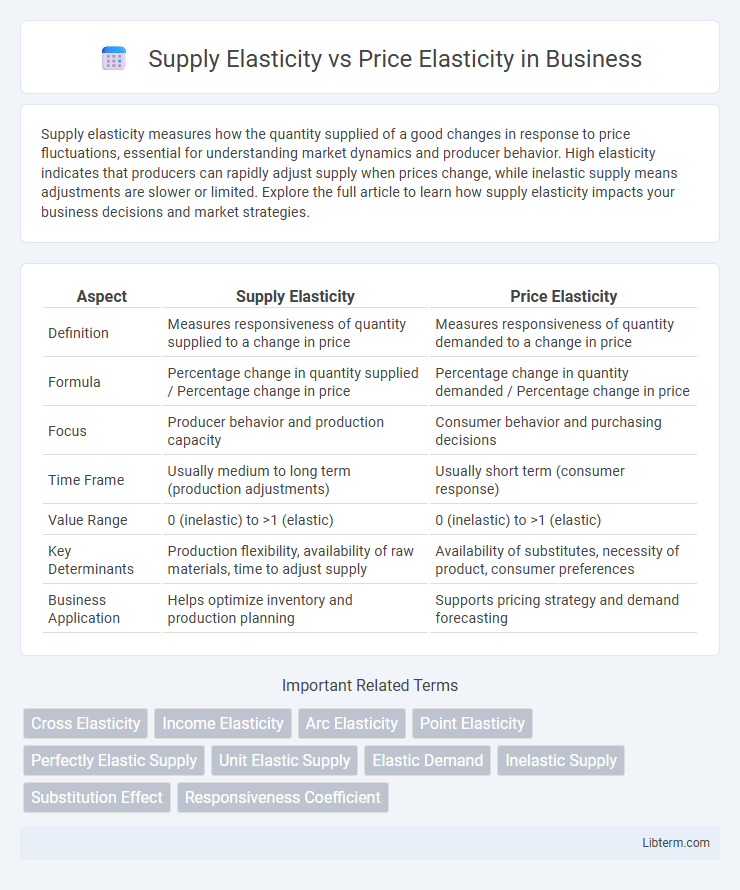Supply elasticity measures how the quantity supplied of a good changes in response to price fluctuations, essential for understanding market dynamics and producer behavior. High elasticity indicates that producers can rapidly adjust supply when prices change, while inelastic supply means adjustments are slower or limited. Explore the full article to learn how supply elasticity impacts your business decisions and market strategies.
Table of Comparison
| Aspect | Supply Elasticity | Price Elasticity |
|---|---|---|
| Definition | Measures responsiveness of quantity supplied to a change in price | Measures responsiveness of quantity demanded to a change in price |
| Formula | Percentage change in quantity supplied / Percentage change in price | Percentage change in quantity demanded / Percentage change in price |
| Focus | Producer behavior and production capacity | Consumer behavior and purchasing decisions |
| Time Frame | Usually medium to long term (production adjustments) | Usually short term (consumer response) |
| Value Range | 0 (inelastic) to >1 (elastic) | 0 (inelastic) to >1 (elastic) |
| Key Determinants | Production flexibility, availability of raw materials, time to adjust supply | Availability of substitutes, necessity of product, consumer preferences |
| Business Application | Helps optimize inventory and production planning | Supports pricing strategy and demand forecasting |
Understanding Supply Elasticity
Supply elasticity measures how the quantity supplied of a good responds to changes in its price, reflecting producers' ability to adjust production levels. It depends on factors like production capacity, time period, availability of inputs, and flexibility of the production process. Higher supply elasticity indicates that producers can quickly increase output when prices rise, while low elasticity implies limited responsiveness to price changes.
Defining Price Elasticity
Price elasticity measures how the quantity demanded or supplied of a good changes in response to a change in its price, specifically capturing consumer or producer sensitivity to price fluctuations. It is calculated as the percentage change in quantity divided by the percentage change in price, providing a dimensionless measure to compare responsiveness across products and markets. Understanding price elasticity is essential for businesses and policymakers to predict the effects of pricing strategies and market interventions on supply and demand dynamics.
Key Differences Between Supply and Price Elasticity
Supply elasticity measures how the quantity supplied of a good responds to changes in its price, reflecting producers' sensitivity to price fluctuations. Price elasticity of demand gauges consumers' responsiveness to price changes, indicating how demand quantity varies with price. Key differences include that supply elasticity pertains to producers and supply adjustment, while price elasticity encompasses consumer behavior and demand variation.
Factors Influencing Supply Elasticity
Supply elasticity measures how much the quantity supplied of a good responds to changes in factors like production cost, technology, or time, while price elasticity specifically examines quantity supplied relative to price changes. Key factors influencing supply elasticity include production flexibility, availability of raw materials, time period for adjustment, and the capacity to store goods. Industries with easily adjustable production processes and readily available inputs tend to have higher supply elasticity, enabling quicker responses to market price fluctuations.
Determinants of Price Elasticity of Demand
Price elasticity of demand depends on factors such as the availability of substitutes, proportion of income spent on the good, and the time period considered. Supply elasticity, distinct from price elasticity of demand, measures how quantity supplied responds to price changes, influenced by production flexibility and resource availability. Understanding determinants like necessity, brand loyalty, and market definition is crucial for analyzing how consumer demand varies with price fluctuations.
Measuring Supply Elasticity
Measuring supply elasticity involves calculating the responsiveness of the quantity supplied to a change in price, typically expressed as the percentage change in quantity supplied divided by the percentage change in price. This metric, also known as price elasticity of supply, varies depending on production flexibility, availability of inputs, and time period considered, offering critical insights into how suppliers adjust output relative to price fluctuations. Accurate measurement helps businesses and policymakers predict supply behavior under different market conditions and is essential for effective inventory and pricing strategies.
Calculating Price Elasticity of Demand
Calculating Price Elasticity of Demand involves measuring the percentage change in quantity demanded divided by the percentage change in price, reflecting consumer responsiveness to price variations. The formula, often represented as PED = (% Change in Quantity Demanded) / (% Change in Price), quantifies how demand fluctuates with price adjustments. This metric is essential for businesses and economists to predict demand shifts and optimize pricing strategies effectively.
Real-World Examples: Supply vs. Price Elasticity
Supply elasticity measures how the quantity supplied changes in response to price variations, illustrated by agricultural products like wheat, where farmers can adjust output moderately based on market prices. Price elasticity of demand reflects how quantity demanded shifts with price changes, exemplified by luxury cars that see significant demand drops when prices rise. Understanding these elasticities helps businesses and policymakers predict market reactions and optimize pricing or production strategies effectively.
Economic Implications of Elasticity Types
Supply elasticity measures the responsiveness of quantity supplied to changes in price, while price elasticity broadly includes both supply and demand reactions to price variations. High supply elasticity indicates that producers can quickly adjust output in response to price changes, leading to more stable markets and efficient resource allocation. Conversely, low supply elasticity can cause significant price volatility and inefficiencies during demand fluctuations, impacting inflation and production planning.
Policy and Business Applications of Elasticity
Supply elasticity measures how responsive the quantity supplied of a good is to a change in its price, influencing producers' decisions in policy-making and inventory management. Price elasticity of demand quantifies consumer sensitivity to price changes, guiding businesses in pricing strategies and governments in tax policy design. Understanding both elasticities enables policymakers to predict market reactions to fiscal measures and helps firms optimize production and marketing for maximum revenue.
Supply Elasticity Infographic

 libterm.com
libterm.com